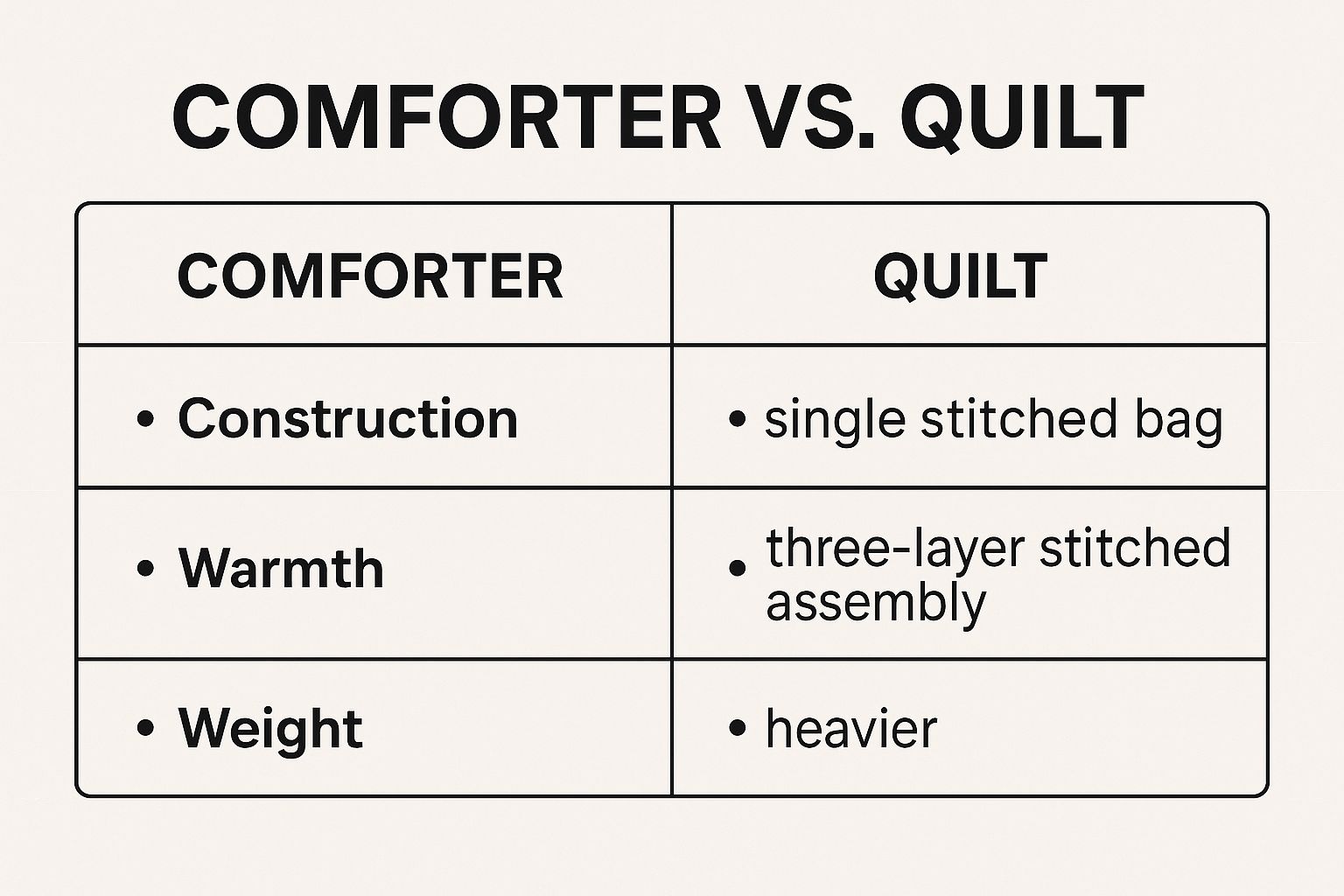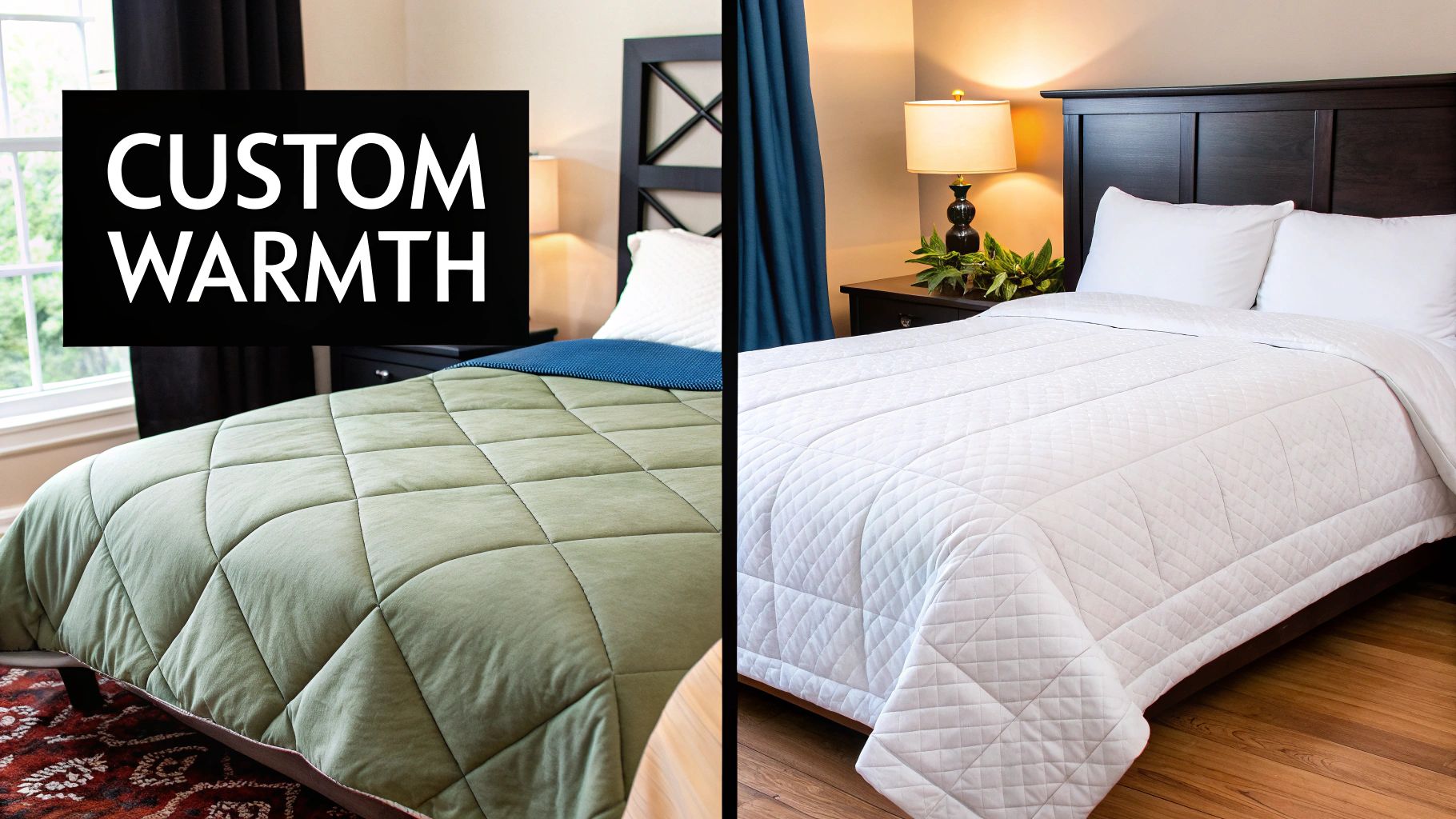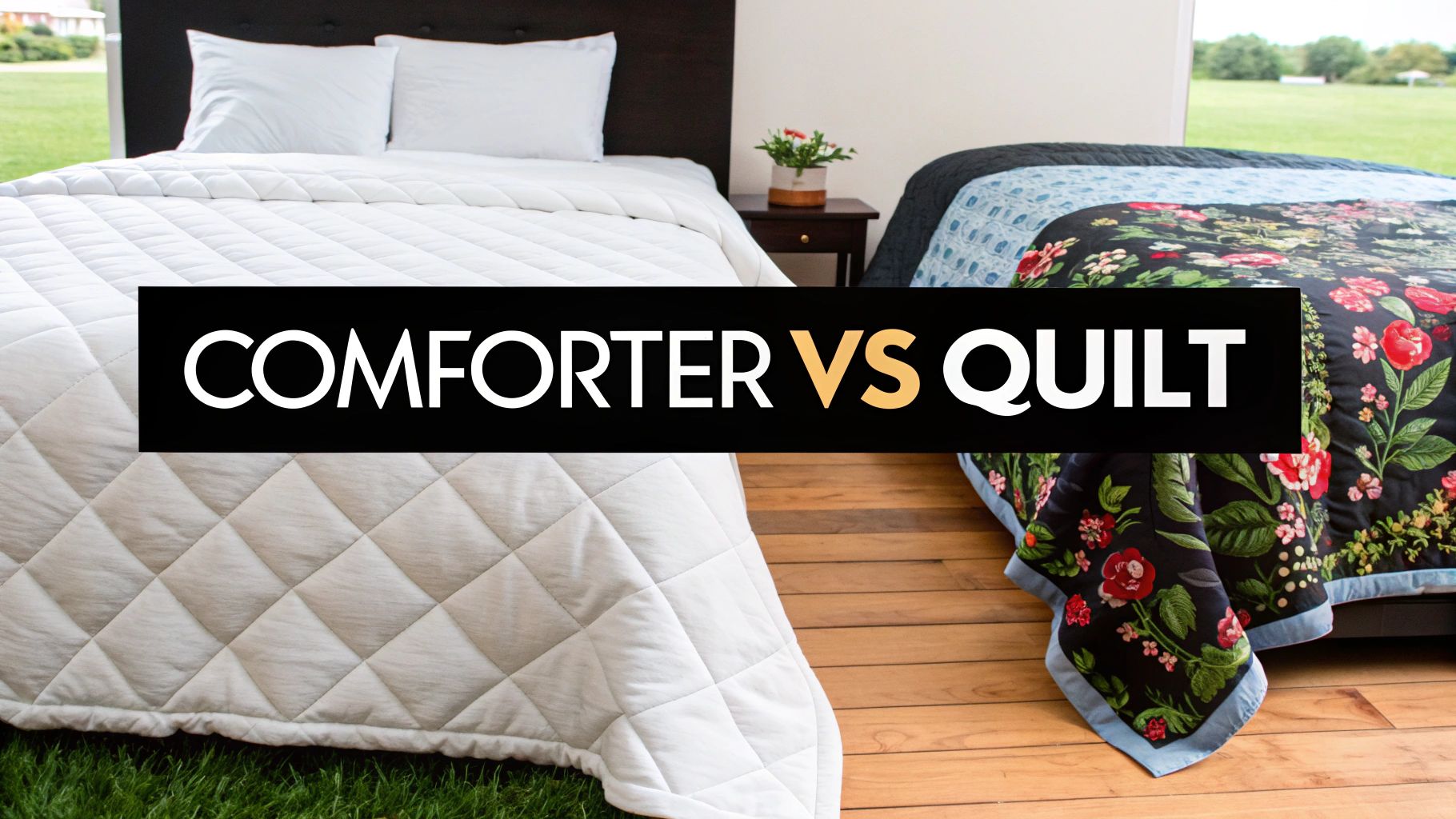Choosing between a cloud-like comforter and a classic quilt comes down to what you want from your bedding. A comforter gives you plush, instant warmth in one lofty package, making it a dream for chilly nights. A quilt, on the other hand, offers lighter warmth with a touch of handcrafted charm, perfect for layering or for anyone who finds heavy bedding a bit too much.
Understanding the Main Differences
Getting your bedding right can completely change how you sleep and how your bedroom feels. Comforters and quilts both promise a cosy night, but they are made differently and have their own unique styles and uses. Knowing what sets them apart is the key to creating a sleep sanctuary that’s just right for you.
This infographic shows you the main differences in how they are made, how warm they are, and how they feel.

As you can see, the choice often depends on whether you crave that sink-in, puffy warmth or prefer a lighter, more decorative layer that you can build upon.
For a quick reference, here is a simple table summarising the key differences.
Comforter vs Quilt at a Glance
| Feature | Comforter | Quilt |
|---|---|---|
| Construction | A single piece of fabric stuffed with down or synthetic fill. | Three layers: a top fabric layer, a thin batting centre, and a fabric backing stitched together. |
| Warmth | High. Designed for standalone use in colder weather. | Low to medium. Ideal for layering or for use in warmer months. |
| Weight & Loft | Heavy and fluffy (high loft). | Thin and flat (low loft). |
| Style | Often solid colours or simple patterns, used with a cover. | Intricate stitched patterns are part of the design. |
| Care | May need professional cleaning due to size and fill. | Usually machine washable at home. |
This table should help you see at a glance which option might suit you best, but let’s explore this a little more.
What to Consider First
Before you decide, take a moment to think about your own habits and home. A few practical points will guide you towards the perfect choice.
- Your Sleep Temperature: Are you the person who is always cold, or do you tend to kick the covers off during the night? Comforters are much warmer and will keep you feeling snug.
- Your Bedroom Style: Do you prefer a clean, simple look, or are you drawn to more traditional, textured designs? Quilts often bring a lot of character and pattern to a room, creating a lovely focal point.
- Ease of Care: Let’s be realistic, how much time do you want to spend on laundry? Quilts are generally far easier to pop into a domestic washing machine.
If you are looking for more ideas, exploring our guide to luxurious bed linens can provide some wonderful inspiration on mixing materials to create the perfect bed.
What is a Comforter?
For many, a comforter is the first thing that comes to mind when thinking of instant, cloud like warmth. It is essentially one soft pouch stuffed with insulating material, then stitched through to stop the filling from clumping together. Picture it as a single plush, cosy blanket that does the job all on its own, with no extra layers needed.
This beautifully simple, all in one design is why comforters are such a popular choice in UK homes. There is no fussing with separate layers, just one piece of bedding that offers serious warmth and a soft, inviting feel straight out of the bag.
Construction and Filling
The secret to a comforter's cosiness is its loft, which is simply the fluffiness created by the filling inside. This filling is fantastic at trapping air, and it is this trapped air that provides such effective insulation against the cold. The outer shell is usually a soft cotton or microfibre, chosen for its gentle feel against the skin.
To keep all that lovely filling evenly spread out, comforters use a couple of key stitching techniques.
- Baffle Box Stitching: This is a more premium construction method. It uses small internal fabric walls to create boxy compartments, giving the filling maximum space to expand. The result is better loft and incredibly even warmth.
- Channel Stitching: A more traditional approach, this involves sewing parallel lines down the length of the comforter. It creates a classic, clean lined appearance while still holding the filling in place.
These construction methods are designed to prevent annoying cold spots, ensuring you stay consistently warm all through the night. Because of their beautiful simplicity, many people choose a colour and style that complements their room, like you can see with this inspiration for a fluffy white comforter that brings a touch of calm luxury.
Of course, the type of filling plays a massive part in how a comforter performs and feels.
The choice between natural down and synthetic fibres really comes down to personal preference for weight, warmth, and allergy considerations. Both are designed to provide that signature enveloping comfort that defines this bedding style.
Natural fillings like goose or duck down are prized for being incredibly lightweight yet exceptionally warm. However, if you have allergies or prefer a vegan friendly option, modern synthetic fibres like hypoallergenic microfibre offer fantastic warmth and a similar plush feel, often at a more accessible price.
The Unique Charm of a Quilt
While a comforter is all about straightforward, puffy warmth, a quilt brings a different kind of character to the bedroom, one that is steeped in tradition, artistry, and lightweight comfort. The charm of a quilt is all in its construction, which is a world away from its fluffier cousin. It is not just a single piece of bedding, it is a carefully assembled sandwich of three distinct layers.

This layered design is what gives a quilt its signature flat, dense feel. It also opens up a world of possibilities for beautiful textures and intricate patterns, allowing you to turn your bed into a genuine work of art.
How a Quilt Is Made
The real magic of a quilt lies in its three part structure, a technique refined over generations. Each layer has a specific job to do, and together they create a final piece that perfectly balances style and practicality. It is this craftsmanship that makes a quilt so special.
This time honoured method is also what makes them so durable and often cherished for years. The layers are:
- The Top Layer: This is the quilt’s decorative face. It is often a patchwork of different fabrics pieced together to create a stunning pattern or a single, beautifully printed fabric.
- The Batting: This is the thin, inner filling, usually made of cotton or wool wadding. It is what provides the warmth without adding lots of bulk.
- The Backing: A solid piece of fabric that forms the bottom of the quilt, completing the 'sandwich'.
These three layers are fused together by the stitching, which is known as ‘quilting’. This stitching is not just there to hold everything in place, it is an art form in itself, creating the wonderful textured patterns that give each quilt its visual appeal. The result is a piece of bedding that feels both substantial and surprisingly lightweight.
For more on how to get the perfect drape and look, you can find details on sizing in our guide on what size is a king quilt.
A quilt is incredibly versatile. It’s light enough to use on its own during those warmer UK nights, but it's also the perfect extra layer when the temperature drops, adding both warmth and a touch of decorative flair.
Comparing Warmth and Weight
When it comes down to it, one of the most important questions is simple: which one will keep you warmer? Deciding between a comforter and a quilt often hinges on understanding their thermal properties. After all, your personal comfort and a good night's sleep depend heavily on the warmth and weight of your bedding.
A comforter is, without a doubt, the champion of warmth. Its design is all about generous, lofty filling that is specifically engineered to trap air. This creates a highly effective insulating barrier, holding in your body heat and keeping you toasty. It is the perfect single layer solution for those biting UK winter nights or for anyone who generally feels the chill.

With a good comforter, you get that maximum cosiness without having to pile on lots of separate blankets.
The Quilt: A Lighter, Adaptable Choice
A quilt, on the other hand, offers a much lighter level of warmth. Its classic three layer construction, with that thin inner batting, provides a gentle insulation that is absolutely ideal for milder seasons like spring and autumn. This makes it a fantastic choice for people who tend to sleep hot or find heavier bedding a bit too restrictive.
If you often struggle with overheating at night, it might be worth exploring our guide on cooling comforters for more specialised options. The real strength of a quilt, though, lies in its adaptability.
In the UK, bed linen, including quilts, makes up a huge portion of the home textile market, accounting for almost 46.36%. This popularity really speaks to their versatility. They are often chosen for their stylish look and lighter weight, which is why you will frequently see them in hotels and guest rooms where adaptable comfort is essential.
The Power of Layering
This is where quilts truly come into their own, especially given the UK’s famously unpredictable weather. Instead of completely swapping out your main bedding with every season, you can use a quilt to build a flexible, layered system.
By layering a quilt over a sheet in summer or adding it on top of your comforter in the depths of winter, you can fine-tune your bed’s warmth to be just right, no matter what the weather decides to do.
This practical approach has a few key advantages:
- Customisable Comfort: You can easily add or remove a layer to perfectly match your personal temperature needs.
- Year Round Use: Your bedding can adapt seamlessly from the warmest summer evening to the coldest winter night.
- Stylish Flexibility: Layering different textiles adds texture and depth to your bedroom décor, giving it a sophisticated, curated feel.
Ultimately, a comforter provides powerful, straightforward warmth in one plush package. In contrast, a quilt offers lighter, more adaptable comfort that can be layered to perfection for any season.
Matching Bedding to Your Bedroom Style
Your bedding does more than just keep you warm, it is one of the biggest players in defining your bedroom’s overall feel. Whether you choose a comforter or a quilt can completely shift the atmosphere of your sanctuary, so let’s break down the different style statements each one makes. This should help you figure out if you are after a clean, unified look or something a bit more layered and artistic.
A comforter tends to bring a sense of plush, modern simplicity to a room. Its lofty, cloud like appearance gives the bed an instantly inviting and luxurious look. Because they often come in solid colours or with simple, clean patterns, comforters are fantastic for creating an effortless, coordinated aesthetic. They are perfect if you are aiming for that minimalist or contemporary hotel chic vibe.
The Comforter for A Clean Look
If you are someone who loves a tidy, uncluttered space, a comforter is a brilliant choice. It really works as a single, statement piece of bedding that smooths over the entire bed for a sleek, polished finish. This approach is particularly effective in modern, Scandinavian, or minimalist interiors where simplicity is key. A crisp white or soft grey comforter, for instance, can make a room feel incredibly calm and serene, turning it into a true retreat.
The Quilt for Character and Charm
On the other hand, a quilt is the perfect way to bring in texture, pattern, and a bit of heritage. Quilts often feature intricate stitching and vibrant, detailed designs that can easily turn your bed into the room's main focal point. A quilt adds a layer of personality that a comforter, by its nature, often cannot.
Whether it’s a traditional patchwork design for a rustic, cottage feel or a bold geometric pattern for a modern twist, a quilt adds a unique, curated touch. It almost tells a story, bringing a sense of artistry and craft into your decor.
This distinction matters, especially in the growing UK bed linen market, which is projected to expand to $3,420.21 million USD by 2035. While the industry sometimes lumps them together, quilts are generally seen as an aesthetic choice for adding custom character. Comforters, in contrast, tend to appeal more to those seeking straightforward, plush warmth. You can discover more insights about the UK bed linen market on Spherical Insights.
A Practical Guide to Care and Durability
Good bedding is an investment, so knowing how to look after your comforter versus your quilt is crucial for making it last. The real difference in care comes down to their construction and sheer size, which dictates how you will keep them looking and feeling fresh.
A comforter's lofty fill is what makes it so cosy, but that same bulk can make cleaning a bit of a mission. Many are simply too big for a standard home washing machine, often requiring a trip to the professionals to prevent the filling from clumping or getting damaged. This is why we always suggest using a separate duvet cover, it protects your comforter and can be stripped off and washed with your regular sheets, keeping laundry day simple.
Everyday Practicality
This is where quilts really shine. Their thinner, less cumbersome design means most fit comfortably into a domestic washing machine, no problem at all. That convenience makes them a brilliant choice for busy families, children's rooms, or guest bedrooms where you need to wash bedding more frequently.
When it comes to durability, the construction of each piece tells a different story.
- Quilts: A properly made quilt is designed for the long haul. That intricate stitching running through all three layers creates an incredibly resilient textile that handles years of use. With the right care, a quality quilt can easily become a treasured heirloom passed down through generations.
- Comforters: The lifespan of a comforter often comes down to its filling. With time and use, the internal stuffing can sometimes shift or lose its fluffiness, although good quality stitching and baffling go a long way in preventing this.
To keep that cloud like softness in perfect condition, we have put together detailed instructions in our Snuggle Comforter care guide. It has everything you need to know to get the most out of your cosy bedding.
Understanding Cost and Value
Let’s talk money. When you are weighing up a comforter versus a quilt, the price tags can look quite different. It is easy to focus on the initial cost, but I always advise thinking about the long term value. A higher quality piece might feel like a splurge at first, but it often pays for itself with years of better comfort and lasting style.
With a comforter, the price is almost entirely driven by what is inside. A truly luxurious goose down comforter, for instance, will command a higher price because it delivers incredible warmth with barely any weight. On the other side of the coin, you will find comforters with top notch synthetic fillings that offer fantastic, hypoallergenic warmth at a much more accessible price, making them a brilliant, practical choice.
What Determines the Price
For quilts, the cost is much more about the craftsmanship and the quality of the fabric. A quilt crafted from premium cotton or linen with intricate, detailed stitching is going to be more of an investment than one with a simple, printed pattern. You are really paying for the artistry and the hours of work involved.
This idea of value over simple price is a growing trend. The UK bedroom linen market, which covers both comforters and quilts, was valued at around £760 million in 2022 and is projected to more than double by 2030. This boom shows a clear shift, people are now happy to invest in premium, durable bedding for better sleep and wellbeing, a habit many of us picked up after spending so much more time at home. You can dig deeper into these UK bedding market trends on Grand View Research.
Investing in your bedding is really an investment in your own wellbeing. A cheaper option might need replacing sooner, whereas a well-chosen, high-quality comforter or quilt can provide a touch of daily luxury for many years.
In the end, whether you are comparing a comforter vs quilt, here is what it boils down to:
- Filling or Fabric: Natural down and quilts with complex patterns will cost more than synthetic fills and simpler designs.
- Durability: Better materials and high quality stitching mean your bedding will last for years, not just a season.
- Long Term Comfort: The right choice is not just a purchase, it is an upgrade to your sleep quality, night after night.
How to Choose the Perfect Bedding
Deciding between a comforter and a quilt really boils down to your personal preferences and how you live. To make it easier, we have put together a few key points to consider. Think of it as a simple checklist to guide you toward the bedding that will give you years of comfort.
First and foremost, think about how you sleep. Are you someone who is always cold and piling on the blankets, or do you tend to get warm overnight? For that deep, cocooning warmth, a comforter is almost always the best bet. If you prefer something lighter that you can easily layer, a quilt offers fantastic flexibility.
Your Personal Checklist
Next up, let’s consider your lifestyle and the look you are going for in your bedroom. Answering these simple questions will quickly clarify whether you are on Team Comforter or Team Quilt.
-
What is your bedroom's style? If you are aiming for that plush, cloud like aesthetic often seen in minimalist or modern rooms, a comforter provides a single, lofty layer. On the other hand, if you love rich textures, intricate patterns, and a more curated, layered look, a quilt is a brilliant way to add personality.
-
How much time do you have for laundry? Let’s be practical. Quilts are typically much easier to pop into a standard home washing machine. This makes them a great choice for busy households or children's rooms. Comforters, especially larger or down filled ones, often require a trip to the launderette or professional cleaning, though using a duvet cover can certainly help.
-
What is your budget? It is always wise to think about the long term value. A high quality piece, whether it is a premium down alternative comforter or a beautifully crafted quilt, is truly an investment in your sleep quality.
Of course, you do not actually have to pick just one. For the ultimate combination of style and function, why not layer a beautiful quilt over a cosy comforter? It gives you that designer quality finish and ensures you have all the warmth you could ever need.
Got Questions? We've Got Answers
Choosing between a cosy comforter and a classic quilt often brings up a few questions. We understand. To help you make the best choice for your bedroom, we have put together answers to some of the things our customers ask most often.
Can I Use a Quilt in Winter in the UK?
You certainly can. While quilts are lighter than comforters on their own, their strength lies in layering. Think of a quilt as a versatile part of a flexible bedding system.
Simply place it over a flat sheet and blankets to build up warmth as needed. A popular trick for the coldest nights is to lay a quilt over your main comforter for an extra layer of insulation and a beautifully finished look. It is a fantastic way to create a snug, inviting bed.
Do I Need a Cover for a Comforter?
Yes, we always suggest using a duvet cover with a comforter. Their bulky, lofty construction makes them tricky to wash frequently in a standard home machine.
A cover acts as a protective barrier, keeping the comforter itself clean from dust and body oils. You can just slip it off and pop it in the wash with your sheets. This not only makes life easier but also lets you refresh the entire look of your room without having to buy new bedding.
Which Is Better for Someone with Allergies?
Both can be excellent choices, but it depends on what you prioritise. If you love the feel of a plush comforter, just be sure to select one with a hypoallergenic synthetic filling, like microfibre. This helps avoid potential triggers that can sometimes come with natural down fillings.
On the other hand, quilts are a brilliant option for allergy sufferers. Their less dense structure means they do not trap as many dust mites. Crucially, they are much easier to wash at home regularly, which is the best defence against allergens. It really comes down to whether you prefer a hypoallergenic filling or an easier washing routine.
Ready to find your perfect layer of comfort? Discover the luxurious Snuggle Comforter and our entire collection at Morgan & Reid. Explore the range and elevate your sleep at https://www.morganandreid.com.



Share:
Choosing a Beige and White Comforter
Find Your Perfect Fluffy Comforter for Cosy Sleep